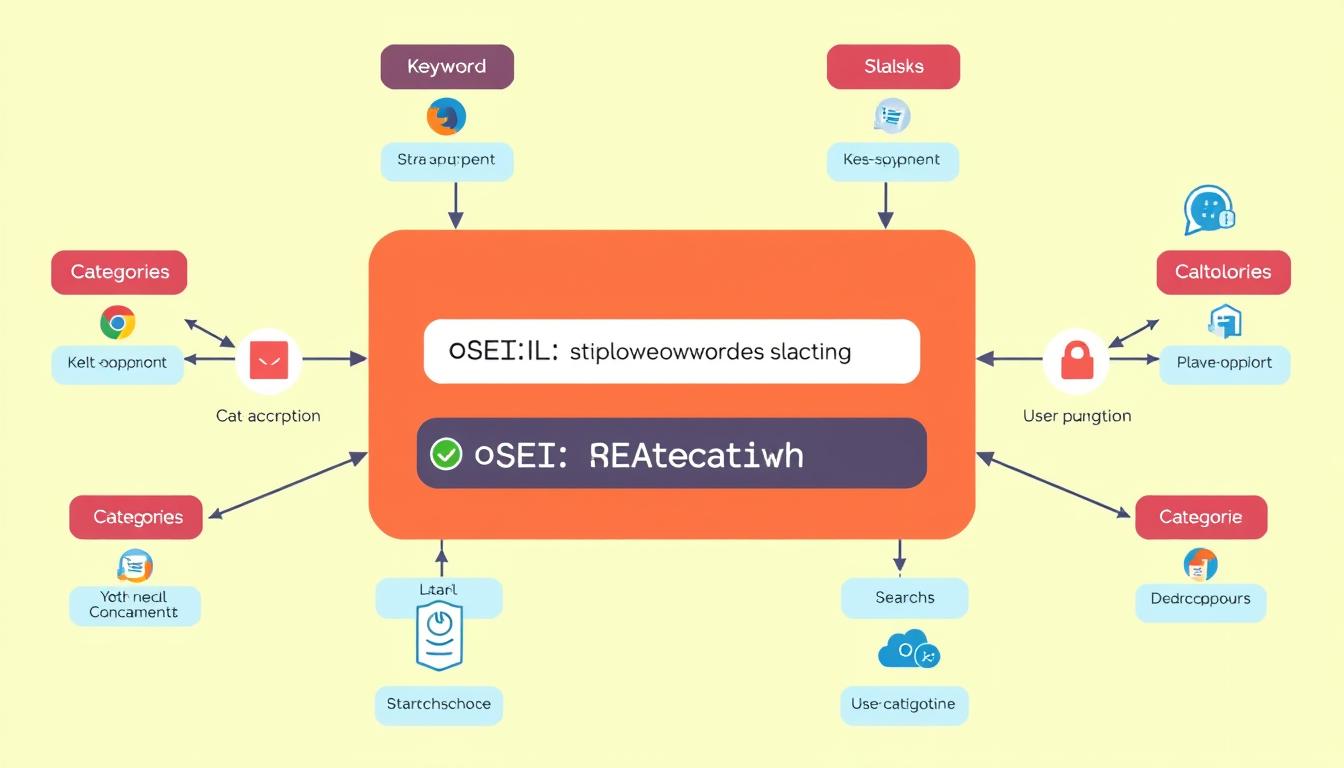Did you know that nearly 70% of marketers believe that an SEO-friendly URL structure plays a crucial role in enhancing website visibility? In today’s digital landscape, mastering the art of crafting effective URLs is no longer optional; it’s essential for anyone looking to improve their search engine optimization (SEO). A well-structured URL not only communicates clarity and relevance to search engines but also significantly boosts user experience.
By adhering to URL best practices, website owners can create paths that guide users smoothly to their content, ultimately leading to increased site traffic. As we delve into the essentials of SEO-friendly URL structure, you’ll discover how implementing strategic optimizations can provide your business with a competitive edge in the bustling online marketplace. For further insights on maximizing your URL potential, check out this article on mastering URL structure for better ranking.
Key Takeaways
- SEO-friendly URL structures enhance search engine visibility.
- Well-crafted URLs improve user experience and engagement.
- Implementing URL best practices can drive more traffic to your site.
- Effective website URL optimization offers a competitive advantage.
- Balanced optimization involves both clarity for users and relevance for search engines.
What is SEO-Friendly URL Structure?
Grasping the concept of SEO-friendly URL structure is paramount for optimizing a website’s performance. A meticulously designed URL acts as a conduit for search engines and a navigational aid for users, facilitating effortless access to your content.
Definition of SEO-Friendly URLs
An SEO URL structure encompasses URLs that are both clean and laden with relevant keywords, rendering them comprehensible to both search engines and users. This approach not only boosts indexing probabilities but also accurately reflects the page’s content. For example, a URL such as www.example.com/seo-tips clearly communicates the page’s subject matter, thereby enhancing user engagement.
Importance of URL Structure in SEO
The significance of a structured URL in website URL optimization cannot be overstated. Such URLs contribute to higher click-through rates by providing clarity and relevance. Search engines integrate URL structure into their ranking algorithms, thereby influencing your site’s visibility. When users can discern the page’s topic from its URL, the propensity for them to click through is substantially increased.
Key Components of an SEO-Friendly URL
The creation of SEO-friendly URLs necessitates the integration of several critical elements, pivotal for enhancing search engine rankings and user interaction. Optimizing URLs for SEO mandates a focus on keyword inclusion, URL length, and the overall structure and readability. These factors are indispensable for achieving optimal results.
Keywords in URLs
The inclusion of pertinent keywords within URLs significantly boosts search visibility. It is advisable to employ specific, descriptive keywords that are directly related to the page’s content. This approach aligns with established URL best practices, facilitating comprehension by both users and search engines regarding the page’s context.
Length of the URL
It is generally recommended to maintain URLs under 60 characters to ensure their full visibility in search results. Shorter URLs contribute to optimization and enhance usability. A concise URL exemplifies a best practice in URL structuring, enabling users to swiftly discern the page’s topic.
Structure and Readability
A URL should be structured in a manner that promotes readability, thereby enhancing user experience. This entails avoiding the use of complex strings of numbers or characters. URLs that are clear and organized support SEO optimization by clearly delineating the website’s hierarchy. For guidance in crafting effective URL structures, consider reaching out through this contact page.
Best Practices for Creating SEO-Friendly URLs
The creation of SEO-friendly URLs necessitates the adoption of methodologies that augment both visibility and usability. The implementation of efficacious SEO-friendly URL guidelines is instrumental in enhancing user experience and concurrently, search engine rankings. An examination of pivotal considerations follows.
Use Hyphens to Separate Words
The employment of hyphens as separators between words enhances readability for users and facilitates search engines’ comprehension of the URL’s content. This principle, a cornerstone among URL SEO tips, significantly impacts performance.
Keep URLs Short and Descriptive
A URL that is both concise and descriptive offers a transparent insight into the page’s content. The imperative of brevity in URL construction is underscored by its role in user engagement and the encouragement of sharing and linking.
Avoid Special Characters and Parameters
It is prudent to eschew the inclusion of special characters and intricate parameters in URLs. These elements can perplex users and impede search engine indexing. A streamlined URL structure is pivotal for superior performance and adherence to SEO-friendly URL guidelines.
For a more comprehensive understanding, consider delving into this resource on URL best practices to refine your website’s SEO strategy.
Common Mistakes to Avoid in URL Structuring

The art of crafting an SEO-friendly URL structure necessitates an awareness of the pitfalls to circumvent. Numerous common errors can subvert your optimization endeavors. It is imperative to remain abreast of these missteps to enhance your website’s online presence.
Keyword Stuffing
Keyword stuffing represents a significant blunder in URL structuring. Overloading a URL with excessive keywords can diminish its efficacy and potentially incur penalties from search engines. Adherence to URL best practices mandates a judicious selection of the most pertinent keywords, ensuring an optimized SEO-friendly URL structure.
Using Dynamic URLs
Dynamic URLs, characterized by their numerous parameters, pose difficulties for both users and search engines. Such URLs often appear convoluted, potentially discouraging user engagement. By simplifying your URLs to clear, direct structures, you enhance usability while conforming to URL SEO tips.
Ignoring Canonical Tags
The omission of canonical tags on pages with analogous content can precipitate duplicate content issues. This scenario confounds search engines, ultimately impacting your search rankings. The deployment of canonical tags facilitates the designation of the primary content version, thereby fostering a more streamlined and efficient URL structure.
Tools to Analyze URL Structure
Understanding the intricacies of URL structure is paramount for aligning with SEO best practices. A plethora of tools for URL analysis exists to facilitate this endeavor. Notably, Google Search Console and specialized URL structure checker tools stand out as essential resources.
Google Search Console
Google Search Console offers profound insights into Google’s interaction with your website’s URLs. It enables users to monitor the performance of URLs, track search performance, and identify crawling and indexing issues. This data empowers website owners to refine their SEO-friendly URL structure, making informed decisions based on actionable insights.
URL Structure Checker Tools
These tools scrutinize existing URLs against SEO standards, offering recommendations for enhancement. They ensure URLs are not only accessible to users but also optimized for search engines. By integrating these tools into their SEO strategy, individuals can significantly boost their online presence. For further guidance, resources such as URL structure guides provide comprehensive advice on achieving optimal practices.
How URL Structure Affects User Experience

The significance of URL structure in shaping user experience cannot be overstated. An SEO-friendly URL structure, characterized by its organization and clarity, profoundly influences user interaction with a website. This, in turn, shapes their perception of the site and its content.
Readability and Usability
Readable URLs are instrumental in facilitating smooth navigation for users. When URLs are straightforward and informative, they enhance usability. This clarity allows visitors to anticipate the content behind the link, leading to a more positive interaction. For effective website URL optimization, consider the following:
- Use descriptive words that reflect the page content.
- Avoid complicated parameters that may confuse users.
- Ensure the URL is easy to remember and share.
Trust and Credibility Factors
Trust and credibility are paramount in user experience. Users are more likely to engage with links that appear legitimate and reliable. An SEO-friendly URL structure fosters this sense of trust. Users can easily identify the content that will be presented to them, which leads to higher click-through rates. A credible URL may consist of:
- Clear hierarchy indicating the website’s structure.
- Use of well-placed keywords that users might search for.
- Consistent branding and logical organization.
The Role of Keywords in URL Structure
In the domain of SEO-friendly URL structure, the strategic inclusion and positioning of keywords within URLs is of paramount importance. This integration significantly boosts both visibility and relevance, thereby drawing in potential visitors. The objective is to strike a harmonious balance between keyword presence and user experience.
Placement of Keywords
Optimizing URLs for SEO necessitates the strategic placement of keywords within the URL hierarchy, which profoundly impacts search engine recognition. Keywords should be situated at the outset of the URL for optimal effect, encapsulating the page’s content essence. This approach not only facilitates search engine indexing but also enhances user trust and usability by providing clear context.
Balancing Keywords with User Intent
It is crucial to maintain a delicate equilibrium between incorporating keywords in URLs and reflecting user intent. Excessive keyword inclusion can be perceived as spammy, negatively impacting both user perception and search rankings. Instead, prioritize crafting informative and descriptive URLs that align with user queries. Aiming for clarity in your URL structure will elevate engagement and click-through rates, thereby making the content more appealing and accessible.
Establishing a well-structured URL with pertinent keywords forms a solid base for effective optimization. By merging simplicity with a strategic keyword approach, one can develop a robust URL structure that fulfills both SEO requirements and user expectations. For additional insights and strategies on achieving this equilibrium, delve into expert tips that elevate your website’s overall performance.
Implementing a Consistent URL Strategy
The establishment of a consistent URL strategy is paramount for optimizing website URLs. It fosters a clear, structured site, advantageous for both users and search engines. A meticulously defined URL mapping strategy enhances user experience and facilitates effortless navigation across the website.
URL Mapping for Website Pages
URL mapping entails the organization of page links within a website. This structured methodology facilitates the creation of an SEO-friendly URL structure, enhancing visitor comprehension of information hierarchy. When formulating a consistent URL strategy, consider the following:
- Define categories and subcategories clearly.
- Use straightforward and relevant keywords.
- Ensure that URLs reflect the content of the page accurately.
Updating URLs Without Losing Traffic
When URL updates are imperative, employing redirection techniques is critical to prevent traffic loss. The implementation of 301 redirects ensures a seamless transition for both users and search engines. Key considerations for maintaining a consistent URL strategy during updates include:
- Inform users about the change where applicable.
- Monitor traffic and rankings post-update for adjustments.
- Maintain the new URLs in line with the original structure.
Monitoring the Performance of URLs
The optimization of an SEO-friendly URL structure necessitates the diligent monitoring of URL performance. Through regular tracking, one gains a profound understanding of the influence these URLs exert on search rankings and user engagement. This knowledge is pivotal for refining web presence strategies.
Tracking SEO Performance
Employing tools for URL analysis, such as Google Analytics, unveils invaluable user interaction insights. These instruments enable website proprietors to discern which URLs are pivotal in driving traffic and which may necessitate adjustments for enhanced performance. Critical metrics to scrutinize encompass:
- Visitor Traffic for Each URL
- Bounce Rates on Specific Pages
- Conversion Rates Linked to URLs
Using Analytics Tools for Insights
Analytics tools furnish a vast array of data for performance monitoring. They unveil patterns in user behavior and pinpoint areas where the SEO-friendly URL structure can be optimized. By leveraging these insights, businesses can make strategic decisions to bolster their web presence.
Conclusion: The Impact of SEO-Friendly URL Structure on Rankings
An SEO-friendly URL structure is pivotal in determining a website’s visibility and performance within search engine results. By adhering to best practices, such as incorporating relevant keywords and ensuring clarity and brevity, website owners can significantly enhance their search engine rankings. A well-structured URL facilitates easier crawling and understanding by search engines, thereby improving the overall user experience, a critical factor for visitor retention.
Our discussion underscores the importance of clarity and consistency in URL formation. This approach directly correlates with the impact on rankings; a logical and straightforward URL structure is more likely to receive favorable attention from both users and search engines alike. Implementing these strategies serves as a fundamental building block for effective digital marketing and SEO initiatives, setting the stage for long-term success.
Recognizing the importance of an SEO-friendly URL structure is essential for any digital marketer or business aiming to thrive online. As competition continues to intensify, an effective URL strategy can provide a competitive edge by enhancing visibility and improving overall performance in search rankings.
